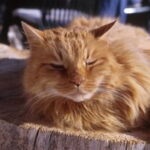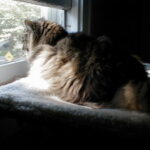There are many myths and rumors about how cats’ eyes work, including the belief that felines can “see” in the dark. But how exactly do cats’ eyes function so well and what gives felines such excellent vision?
If you want to know how a cat’s eye works, it might be helpful to begin by looking at your own cat – or that of a friend, relative or neighbor.
How a Cat’s Eye Works – Start by Looking at the Feline’s Pupil
If you look at a cat’s eyes in bright light, you should see a slit or an elliptical pupil. In darker light, the entire eye may appear larger, including the pupil.
Having a pupil that can narrow down to a slit helps protect the cat’s vision in bright light. Sharper, clearer details are seen by the feline, leading to better vision in cats (far superior to human vision). Also, an interesting bit of trivia, shared by Indianapolis veterinarian Carl Budelski: the typical domestic cat has an elliptical pupil but lions and other Big Cats have rounder pupils.
Cats have Large, Mysterious Eyes – the Better to See You – and Prey
Those large, mesmerizing eyes of the cat? They are more than beautiful but also one of the reasons that a cat’s eyes work so well. Those relatively large eyes allow extra light to enter the cat’s eyes. More light helps cats see better in low light situations. The result? Better overall vision in cats.
How a Cat’s Eyes Work – Move on to the Tapetum Lucidum
Don’t worry if you’re thinking “Huh?” at this point. You’ve probably never heard of this part of a cat’s eyes or how they help a cat’s vision. The tapetum lucidum works much like a mirror and is located at the back of a cat’s eye. When reflected light hits special sensors a cat sees more details.
Also, did you ever notice how a cat’s eyes glow, sometimes with a reddish or yellowish tint, when light shines in them? You can credit that to the tapetum lucidum. It gives cats a clear advantage when it comes to seeing small objects in even very dark rooms. The tapetum lucidum is a major reason why cat have such wonderful vision.
A Cat’s Eye Works Well Because of the Number of Rods and Cones in the Eye
Because cats have a large concentration of rods in their eyes, their night vision is excellent. Contrary to some popular myths, felines do not actually see in complete darkness. A cat’s vision is also much better than humans, partially because of special cones. A cat can see with only about a sixth of the light a human needs because the cones are sensitive to large amounts of light and aid in seeing color (yes, it is believed that cats can see in color).
Cats’ Eyes May Work Better with the Aid of a Third Eyelid
If you’ve ever experienced vision problems on a dry or dusty day, you might have wished for an extra eyelid. Cats have a third eyelid, known as a nicitan (or nictitating membranes if you are referring to both of the cat’s eyes). This is an extra layer of protection for the cat and helps keep the eye free of dust, debris and other objects which could impair the cat’s vision.
The third eyelid is located between the lower eyelid and corner and the cat’s eye. You may have seen this while a cat is dozing or barely sleeping. When fully awake, the membrane is not visible but may be seen (if you look closely) when a cat blinks.
When A Cat’s Eyes Don’t Work Right – Vision Problems
Although some cats have vision problems that are easily noticed, including redness, swelling and discharge from the eye, other eye diseases which can cause vision problems in cats may only be detected by a careful examination and diagnosis by a qualified veterinarian. Regular check-ups by a veterinarian specializing in the treatment of cats may help detect vision problems in cats before they become serious – or lead to blindness.
Sources
Personal experience
Interview with Dr. Carl Budelski, Indianapolis veterinarian (317) 848-0318



